730: Circuit Diagram
| Circuit Diagram |
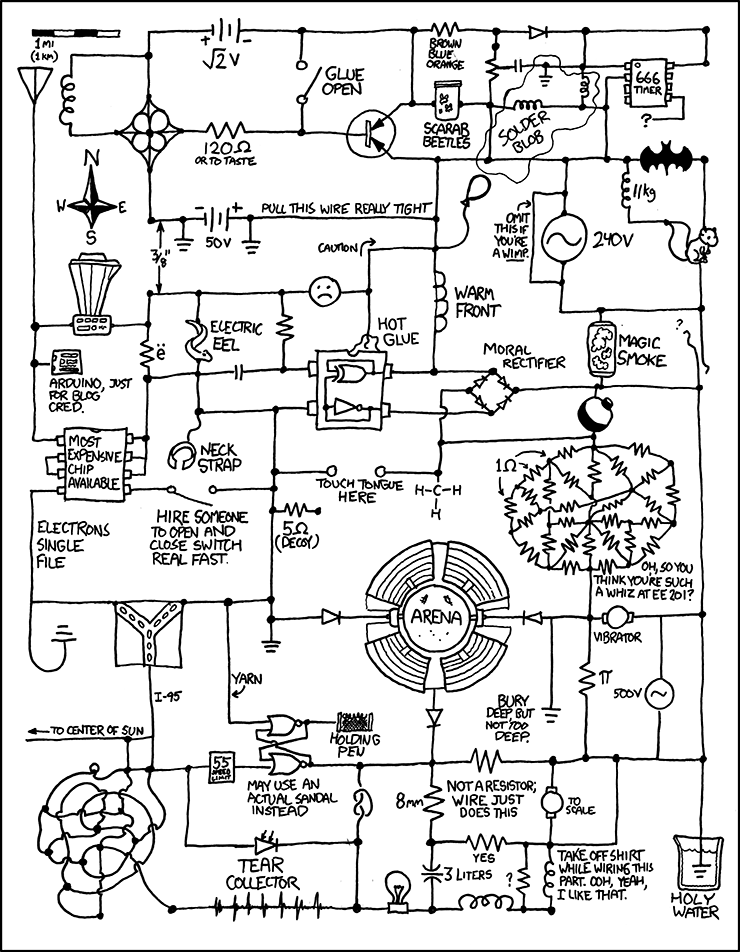 Title text: I just caught myself idly trying to work out what that resistor mass would actually be, and realized I had self-nerd-sniped. |
Explanation
Another fine example of nerd sniping. There are pieces of circuit diagrams, road maps, chemical diagrams, and other things all mixed in. Explanations for each below!
| Image Fragment | Image Location | Description |
|---|---|---|
| |
106×37 @ 19,25 | A map scale. Lists kilometers and miles as equivalent. And makes the diagram many miles wide. |
| |
40×85 @ 15,62 | An antenna. Typical of radio receivers or transmitters. Or the Turtle in LOGO programming language |
| |
41×87 @ 53,60 | A coil or inductor. Normal, but unlabeled. |

|
85×93 @ 107,86 | A cloverleaf interchange or junction is a feature of road networks that does not belong in a circuit diagram. Of course, other types of junction are important in electronics.
A cloverleaf junction has previously been used in comic: 253: Highway Engineer Pranks |

|
87×63 @ 184,12 | A battery. The voltage of square root of two is strange, but getting about 1.41412... volts is not unheard of. The marked polarity is also the reverse of what is implied by the symbol (where the larger terminal is positive). |

|
94×71 @ 187,110 | A 120 ohm resistor is normal enough. "Or to taste" is odd for a circuit diagram and more like instructions from a recipe, e.g., "1 tbsp tomato purée, or to taste". |

|
90×63 @ 283,50 | A normal switch, with a notation to glue it open. Reminiscent of the MAGIC/MORE MAGIC switch. |

|
69×64 @ 337,101 | A bipolar PNP transistor, except that it has two emitters and no collector. |

|
79×107 @ 52,141 | Compass points. A map feature, not a circuit feature. |

|
63×58 @ 415,18 | A normal resistor, labeled with color code. Brown-Blue-Orange would be 16000 ohms. Resistor color codes are for reading the value on the physical device itself. They would not normally be shown on the circuit diagram, where it's much easier to just write the number, e.g. 16K. |
| |
42×32 @ 517,14 | A normal diode. |

|
73×74 @ 615,55 | A chip. The normal timer is a "555". "666" would be the number of the beast in Rev. 13:18. The pin connected to "?" is the CTRL pin on a normal 555 timer, which would typically be connected to ground (via a decoupling capacitor) if used at all; the implication here seems to be that it would be connected directly to Hell itself. |
| |
69×41 @ 632,138 | A Batman logo. |

|
75×71 @ 650,211 | A squirrel, or a wire bent into the shape of a squirrel. What it does as a circuit element is unclear. |

|
54×53 @ 606,165 | A coil or inductor, or a spring symbol in Physics force diagrams, probably the latter as it is labeled with an 11-kilogram mass. |

|
99×59 @ 538,209 | A 240-volt AC generator (or other power source). |
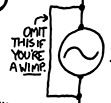
|
111×103 @ 483,186 | A shorting wire around a generator. The label reads "Omit this if you're a wimp." If this wire is included, it will quickly melt - or worse. |

|
57×75 @ 419,78 | A jar of scarab beetles. |
| |
28×44 @ 482,47 | A variable resistor with center tap. Normally, there would be an arrowhead on the center tap. |
| |
22×27 @ 507,53 | A normal capacitor. |

|
96×62 @ 577,318 | "Magic Smoke" is the legendary stuff inside a chip that comes out when it fails. |

|
51×66 @ 669,315 | Some frayed or dangling wires. |
| |
58×48 @ 567,392 | An object which is either a float used in fishing, a Tippe top, or perhaps a mine. |

|
111×86 @ 458,336 | A bridge rectifier, which would normally turn alternating current at the top and bottom into direct current on the left and right. In this case, it is labeled as a "moral rectifier". This is presumably a play on the idea of moral rectitude – it makes your circuit more moral. Why this matters in a circuit is unclear. |

|
80×85 @ 423,259 | A warm front is a feature on a synoptic weather map. |

|
54×52 @ 190,199 | A normal 50-volt battery. |

|
89×56 @ 173,200 | A battery is grounded on both sides. Something will melt or burn out quickly, unless these are separate "earth ground"s, in which case the ground might get a bit cooked. |
| |
174×25 @ 259,198 | Text reads "Pull this wire really tight". This kind of physical-property issue may indicate a high-frequency radio device. Or, given the absurdity of the context, it's a silly reference to a "high tension wire." |
| |
41×91 @ 141,211 | A specified 3/8-inch separation. This probably indicates a carefully controlled capacitance issue. Also contradicts the scale of the drawing, by which the distance shown would be about 0.8 miles or 0.8 km. |

|
92×59 @ 173,309 | An electric eel. This may be an effective power source in the circuit, capable of producing a shock at up to 600 volts and 1 ampere of current (600 watts), but for less than 2 ms. |
| |
35×41 @ 266,307 | A normal resistor. |
| |
34×29 @ 222,358 | A normal capacitor. |
| |
44×40 @ 130,335 | A normal resistor, labeled "ë". This may be a play on Euler's Number, which doesn't normally have an umlaut. Alternatively instead of being an umlaut it may indicate the second derivative derivative of e with respect to time in Newton's notation, in which case, as e is a constant, the resistance of this element is zero. |

|
61×92 @ 65,249 | This appears to be a blender. |

|
115×73 @ 20,342 | An arduino, labeled "Arduino, just for blog cred". May refer to the fact that inexpensive, easy-to-integrate single-board computers like the arduino, which have contributed to the rise of Maker_culture, are used and discussed frequently in that culture, and the use of one might impress readers. The comment implies that an arduino is not otherwise needed in this circuit, although it is necessarily hard to tell, given the other components of the circuit. |

|
118×82 @ 39,423 | A chip labeled "Most expensive chip available". The small curve at the top is a part of the packaging designed to show its orientation. |

|
91×50 @ 159,428 | Labeled "Neck Strap". Perhaps a piece of torture equipment or indicating that the circuit is part of an electric chair? |

|
110×88 @ 147,480 | A switch labeled "Hire someone to open and close switch real fast." Possibly meant to perform the function of an oscillator in a more hackish manner and the reason for the neck strap. Could also be a reference to Maxwell's Demon. |

|
61×64 @ 273,498 | A 5 ohm resistor labeled "(decoy)". One end is not attached to anything. Perhaps this indicates wishful thinking that electrons might be tricked into entering this part of the circuit despite the fact that there's nowhere for them to go? |

|
103×56 @ 307,453 | A pair of contacts, labeled "Touch Tongue Here". Could be referring to the practice of daring someone to touch their tongue to the contacts of a 9V battery. |
| |
45×45 @ 301,270 | A frowny-face. See the float/mine. |
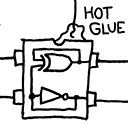
|
128×124 @ 294,311 | A small integrated circuit. The lower gate is an inverter, wired as a free-running oscillator. The upper gate is an XOR wired to act as either a free-running oscillator or a latch. Since the XOR will be slower than the inverter, the overall output of the upper gate is probably very chaotic. Two "input" wires are not connected at all. An additional wire is attached to the top with hot glue. This last wire probably acts to control static electricity and leakage. |
| |
91×25 @ 302,235 | A caution sign at a curve. Another road feature in the circuit. |

|
67×68 @ 401,455 | A methyl group (chemistry) attached to a corner. If the circuit were an organic chemical, it would be reasonable to find a number of these. |
| |
43×93 @ 453,167 | A balloon, possibly blowing in a breeze. |
| |
22×43 @ 572,68 | A coil or inductor. |
| |
42×20 @ 508,96 | A coil or inductor. |
| |
22×31 @ 534,61 | A ground connection. |
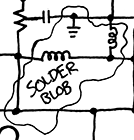
|
134×140 @ 472,49 | A solder blob covering a portion of the circuit. Normally, this would not be part of the circuit diagram, but a mistake in building the circuit. |
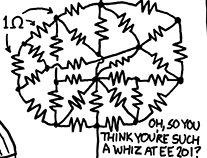
|
207×158 @ 493,443 | A rats nest of 1 ohm resistors. It is labeled "Oh, so you think you're such a whiz at EE201?" EE201 is a US course number for a basic level course in electrical engineering (compare 101). Calculating the effective resistance of this is what the title text refers to. It appears to work out to 0.75800964845 ohms. |
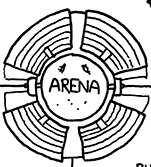
|
232×200 @ 315,533 | An arena, with a few bodies in it. Note the direction of movement enforced by the surrounding diodes, "two men enter, one man leaves" |
| |
47×51 @ 569,653 | A "pi" ohm resistor. |

|
75×70 @ 610,655 | A 500-volt AC generator. The wiring to the right shorts out this generator. |

|
85×64 @ 481,682 | A ground connection, labeled "Bury deep, but not too deep". This type of ground connection is called an "earth ground" The "too deep" part might be a reference to Moria in Lord of Rings. The dwarves dug too deeply and disturbed a balrog. See also comic 760. |

|
75×73 @ 17,610 | A ground connection at the end of a curve, looking like a fishhook. Means perhaps "earthed down under", i.e., Australia or the southern hemisphere. |
| |
66×45 @ 206,662 | A length of "wire" is labeled "yarn". This probably makes it a terrible conductor. |

|
93×88 @ 102,590 | The flux capacitor from Back to the Future. |
| |
54×24 @ 138,685 | A road sign for "I-95". Interstate 95 is the main north-south highway on the east coast of the United States, running from Maine to Florida. |
| |
134×36 @ 12,713 | A connection labeled "To center of Sun". A 93-million-mile circuit is rather large, but... |
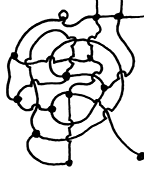
|
144×177 @ 31,753 | A rat's nest of wires. Everything winds up being connected. |

|
97×61 @ 22,513 | A label reading "Electrons Single File". If this happens, the resistance in this section of wire would be rather high. |
| |
29×39 @ 256,619 | A ground connection. |
| |
58×46 @ 589,600 | A vibrator, which would be a motor with an off-center weight attached to it. |

|
74×52 @ 532,779 | A motor, labeled "To Scale". This indicates that the physical size and shape of the motor must match the size of the parts around it, or is consistent with the specified scale of the drawing. |

|
73×109 @ 662,822 | A ground connection, in a beaker labeled "Holy Water", possibly creating Holy ground. |
| |
48×55 @ 197,740 | A sign indicating a speed limit of 55 MPH. This is a rather typical road sign, but inappropriate for a circuit diagram. |

|
100×116 @ 238,706 | A pair of NOR gates wired as a SR (set-reset) flip-flop. The label reads "May use an actual sandal instead", which is a play on the meanings of the term "flip-flop". |

|
70×54 @ 322,708 | Something that could be the side view of a fence, labeled "Holding Pen". |
| |
42×49 @ 339,777 | A simple overhand knot. Also looks like a pretzel, which would have pretty high resistance. |
| |
149×33 @ 191,889 | This appears to be an electrocardiograph (ECG) trace, but not the sort that would be seen in a healthy person. If this were a real ECG trace, the absence of large, clear P waves might indicate fine atrial fibrillation, but in some recording configurations, P waves are sometimes lost in the noise anyway. Additionally, without a time scale to tell us the ventricular heart rate, it is impossible to make a strong educated diagnosis of any hypothetical disease at all. If we assume it is atrial fibrillation, is not clear if Randall intended this, or if he is just not familiar with how a normal ECG should look. |

|
82×68 @ 223,826 | A photodiode, labeled "Tear Collector". A photodiode is a light-sensing device. |
| |
49×68 @ 373,859 | A lamp. This is not the symbol used in electrical circuits, but a drawing of a lightbulb. |
| |
65×32 @ 450,887 | A coil or inductor. |

|
120×72 @ 537,847 | A coil or inductor, labeled "Take off shirt while wiring this part. Ooh, yeah, I like that." |
| |
34×41 @ 504,860 | A resistor labeled "?". Presumably this means the resistance is unknown. |
| |
55×38 @ 459,828 | A resistor labeled "YES". Likely another improper unit - a reference to boolean values YES (TRUE) and NO (FALSE). Depending on the limits of a circuit, a resistor would still have a YES boolean value. Possibly indicating that this is a real resistor, as opposed to the one above it in the circuit, labeled "not a resistor." |

|
58×53 @ 389,774 | A resistor labeled "8 mm". |

|
93×84 @ 443,747 | A resistor labeled "Not a resistor; wire just does this". This may reflect the fact that any wire has a certain amount of resistance just by being a wire, or it may be that the wire is physically bent into a zig-zag shape. |
| |
82×24 @ 415,863 | A symbol for a feedthrough capacitor, labeled "3 Liters". Probable word-play on "capacity/capacitor." Also similar to the symbol for an orifice or flow restriction used on plumbing or hydraulic diagrams, in which case the "3 Liters" might mean 3 liters per minute or per second. |
Transcript
- See table.
Discussion
So, is the arena a new kind of comparator or something? Davidy22[talk] 13:28, 18 February 2013 (UTC)
11:13, 10 April 2013 (UTC)11:13, 10 April 2013 (UTC)Jh6p (talk) The 3 liter capacitor could also be a ball approximately 6 inches in diameter if the seams on the ball were similar to the seams on a basketball. Perhaps a volleyball?
- "A squirrel. What it does as a circuit element is unsure."
Perhaps an allusion to a squirrel cage? Wwoods (talk) 18:51, 22 April 2013 (UTC)
- The shape of the squirrel's tail reminds me of a hysteresis curve, although this is admittedly a bit of a stretch. —Scs (talk) 16:02, 17 November 2013 (UTC)
The 'to scale' motor would be about half a mile wide. Powering the rabbit on Gaia's vibrator (also included)? --StarChaser Tyger (talk) 08:40, 22 June 2013 (UTC)
I beg to differ on the flux capacitor thing, as cool as it sounds. Since it is right above the I-90 notation, it is more likely a fork in the road (notice the road stripes indicating that you can pass at any point in the fork). 97.87.12.114 02:15, 24 June 2013 (UTC)
- Oh, I'm pretty sure it's a flux capacitor. Compare some of these images. Yes, there are several road references in this comic, but an electronic reference (especially to a fictional electronic component!) makes more sense. Also I've never seen a Y-shaped highway intersection that looked quite like that (and especially not on an interstate). —Scs (talk) 14:52, 17 November 2013 (UTC)
I have wasted 4 hours on the puzzle, and after wasting 9 pages of A5 paper, the resistance of that terrible resistor mess worked out to be exactly 25265/33783 ohm, or about 0.74786135 ohm. --KopaLeo 199.48.226.89 15:16, 27 June 2013 (UTC)
I think that the "fishing float" might actually be a picture of an ordinary push switch (similar to foot switches used on standard lamps). 87.194.171.29 16:12, 10 July 2013 (UTC)
Isn't the "YES" resistor a reference to the anecdote of how John Lennon and Yoko Ono met? That's what I thought when I saw it, but then, I kinda like The Beatles a bit. 200.70.22.74 12:27, 16 September 2013 (UTC) Another alternative for the "YES" resistor is a pun: if one was being resistant to an idea you would expect to get "NO' from them. This resistor however says "YES". 172.70.127.53 07:39, 8 March 2023 (UTC)Verisimilidude
I think the attempt to explain every single piece of the comic is rather silly. The humor largely draws from the absurdity of the diagram, and that can probably be summarized without going into detail about the possible references of each individual component. 199.27.130.180 03:22, 26 November 2013 (UTC)
- I disagree. The joke works on multiple levels, both the absurdity of the circuit, and the smaller parts of which it is comprised. Hydroksyde (talk) 02:40, 21 April 2014 (UTC)
I concur with KopaLeo - I got the same answer for the resistance of the grid of resistors - about 0.748 when rounded. What a problem! --techdude 108.162.215.65 20:45, 1 January 2014 (UTC)
I feel like I should point out that putting a ground connection in holy water probably creates Holy Ground 108.162.212.197 11:36, 26 March 2014 (UTC)
- Might also be a reference to demineralised (demin - holy) water toby1 (talk) 03:10, 12 January 2023 (UTC)
To center of Sun could possibly be another map reference. 108.162.250.202 01:08, 19 November 2014 (UTC)
The 'moral rectifier' seems like it's built of diodes which prevent current flow to the left, which might mean it's making the current 'more right'? with right being a synonym for moral? 108.162.212.18 00:15, 17 December 2014 (UTC)
- 3L capacitor
The capacitor reminded me of a time I asked my dad why desktop PCs (the kind we could afford at the time were 200-500 W) couldn't have capacitors to protect them from 1-second or shorter power interruptions without the cost of a UPS. He said such a capacitor would have to be as wide and tall as a 2L pop bottle. (He didn't say how much it would weigh.) Promethean (talk) 04:38, 9 September 2014 (UTC)
Where did the claim that the EKG is atrial fibrillation come from? At best it it hard to tell without a time scale what the ventricular rate is, but there is no evidence of extra P waves between QRS complexes that I see. If the diagnosis is made based on the absence of P & T waves, keep in mind that some recording conditions make those (especially T) hard to see. In an Einthoven's triangle arrangement, they might not show up at all above the noise. If we had a time scale that let us calculate ventricular rate, we might be able to conclude supraventricular tachycardia, but I'm hesitant to make a strong claim that this is abnormal at all given that it's hand drawn and we have no scale.Djbrasier (talk) 21:07, 22 January 2015 (UTC)
Does this really belong in Category:Charts? I'm moving it to Category:Maps instead. gijobarts (talk) 21:38, 19 February 2015 (UTC)
Are we really explaining "vibrator" as "a motor with an off-center weight attached to it"? 141.101.91.97 06:51, 13 March 2015 (UTC)
I just spent 3 hours trying to work out the resistor nest. I was unsuccessful. Mikemk (talk) 05:32, 19 March 2015 (UTC)
I did an LTSpice simulation or the resistor mess. It looks like the 25265/33783 ohm answer above is correct. It drew 1.3371463 amps from a one volt source. 108.162.215.133 (talk) (please sign your comments with ~~~~)
Based on Randall's promotion of international standards (such as ISO 8601), it seems odd that he's using the US zigzag symbol for a resistor, rather than the IEC rectangular one. Walale12 (talk) 21:37, 17 April 2015 (UTC)
Looking at the label "Tear Collector" I think it refers to the heartbeat below it, not the symbol above, suggesting that a heart (or heart break) is a likely source of tears. 108.162.216.44 (talk) (please sign your comments with ~~~~)
I'm not sure why the rat's nest of resistors is considered such a difficult problem. I would like to respectfully point out that by far the easiest way to solve it is by assuming a constant current through the network. You can then assign a name to each of the nodes, set one of the end nodes to 0V, and solve by KCL. Granted, there are 13 unknowns and 14 equations, but it still took less than 30 minutes to complete since they are all 1st order! archerator Archerator (talk) 04:57, 30 August 2015 (UTC)
120×72 @ 537,847: the coil symbol next to "Take off shirt while wiring this part. Ooh, yeah, I like that." is similar in appearance to chest hair in stylized comic strips. Thaledison (talk) 17:19, 5 October 2015 (UTC)
144×177 @ 31,753 - Could the rats next of 1 Ohm resister be a reference the the sign that Blackhat holds up in: https://xkcd.com/356/ as you can't show an infinite numbers of 1 ohm resistors in the diagram? 141.101.98.108 (talk) (please sign your comments with ~~~~)
To me, the arena calls to mind the one in the Labyrinth in the Percy Jackson book series. One of the figures resembles a centaur, which was a gladiator that was defeated in said arena in the scene it is introduced. 108.162.245.46 22:16, 30 October 2016 (UTC)
And here I was thinking that the fishing float was a Pokeball... Whoop whoop pull up (talk) 19:03, 28 April 2017 (UTC)
I think that "take off shirt while wiring this" could be sexual reference- there is "ooh, i like that"
- I always thought that the 555 timer was called so because of the three 5k ohm resistors...apparently it is a myth! Does anybody know the real reason?
Regarding the resistor part - I read http://mathworld.wolfram.com/ResistanceDistance.html and implemented it in Mathematica. g = Graph[{1 <-> 2, 1 <-> 3, 1 <-> 4, 1 <-> 5, 2 <-> 3, 2 <-> 6, 3 <-> 6, 3 <-> 7, 3 <-> 8, 4 <-> 7, 4 <-> 5, 5 <-> 9, 5 <-> 10, 6 <-> 12, 6 <-> 11, 7 <-> 12, 7 <-> 11, 7 <-> 13, 7 <-> 14, 7 <-> 9, 8 <-> 15, 8 <-> 10, 9 <-> 14, 10 <-> 15, 11 <-> 12, 11 <-> 13, 13 <-> 14, 14 <-> 15}]; m = KirchhoffMatrix[g] + 1/15; inverse = Inverse[Table[m[[i, j]], {i, 1, 15}, {j, 1, 15}]]; omega[i_, j_] := inverse[[i, i]] + inverse[[j, j]] - 2*inverse[[i, j]]; omega[1, 13]. The result was 167294/195327 = 0.856482...
I feel that it needs to be electronic eel more than an electric one.
Ok, who the hell did the explanation for Magic Smoke? I even had to make a [REAL Citation needed] sign to indicate that the needed citation wasn't a joke.108.162.242.21 15:02, 4 November 2019 (UTC)
Isn't it 616 not 666 citation[1]--Galactic ascencion (talk) 07:32, 17 March 2020 (UTC)
- Well the image clearly shows a 666. Also the wikipedia article you use as a citation here, states also both numbers. The number should be most famous (at least to people who do not follow the bible/quran word by word and to specific translation) due to its use by iron maiden in the song "the number of the beast" which also states it as 666, and other pop culture references. --Lupo (talk) 10:10, 17 March 2020 (UTC)
Could wimp also stands for weakly interacting massive particles, a candidate of dark matter? Then it will reasonably omit the electromagnetic interactions running in this circuit diagram.--Lamty101 (talk) 14:13, 2 July 2020 (UTC)
- Balloon
The line of the balloon also crosses another circuit, which could be a hazard in itself (flying kites or balloons near high-voltage lines is quite dangerous, and helium-filled balloons are often forbidden in railway stations with overhead catenary). This may also be what the "caution" arrow is indicating. 162.158.159.73 13:14, 22 January 2022 (UTC)
- By my reading, the ballon is anchored at the junction between the caution-bend and the vertical one. I think there's danger of the balloon rising to touch the solder-blob, or other bits above it, but I think its already electrically bonded at the non-balloon end (insofar as 'reality' can be interpreted). Yes, there's possible danger (and you IRL point is true) but it's elsewhere, if not almost everywhere else..! 172.70.162.77 15:34, 22 January 2022 (UTC)
While I won't revert this minor 'correction', I disagree that it was wrong before. "Types of junction" is a plural-phrase already. "One type of junction" vs. "(Two/Many/No) types of junction". (It is the type(s) that is/are singular/plural, what they then are of is similar to a postpositive adjective, but in propositional form. "Types of junctions" reads clunkily.
Caveat: I am approaching this as British English (I hope!) but I extensively looked to see if this was one of those cases* US English differs and failed to find anything at all about it. * - by complete fluke, I wrote "this was one of those cases", which could have been "one of those cases which was", where the plurality agreement does not not ask for "were". Well, except in a certain dialect ("He were, she were, they were, we were ...") not far from another area that goes the other way ("He was, she was, they was, we was, ..."), but that doesn't help matters. ;) 172.70.86.68 16:05, 23 January 2022 (UTC)
- Pi resistor
It was conjectured but unconfirmed that the constant "4 times pi" was once called omega. As the pi resistor in the comic was missing the "Ω" symbol, this "pi" may be a pun on "0.25Ω" to the power of [citation needed]. The "e with dieresis" may also be related. --ColorfulGalaxy (talk) 17:04, 12 January 2023 (UTC)
